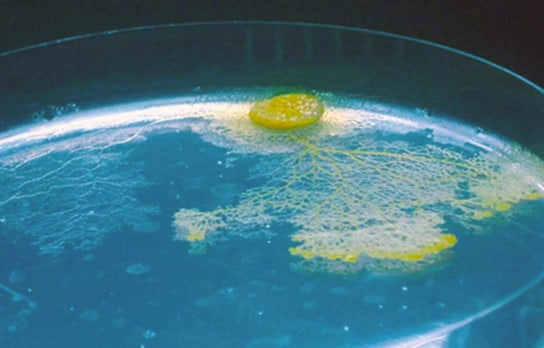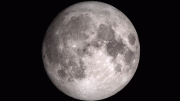
Physarum polycephalum exploring petri dish, Credit: Courtesy of Audrey Dussutour
Slime molds are gelatinous amoebae that are classified as protists, a taxonomic group. Slime molds, while brainless, are smarter than they look. Physarum polycephalum can solve mazes, mimic the layout of man-made transportation networks, and choose the healthiest food from a menu.
P. polycephalum rummages through leaf litter and oozes along searching for bacteria, fungal spores and other microbes that it envelops and digests. Although it acts like a colony of cooperative individuals foraging together, it spends most of its life as a single cell containing millions of nuclei, small sacs of DNA, enzymes and proteins.
It takes on different appearances depending on where and how it is growing. In the forest, it might fatten into giant yellow blobs or remain a smear of mustard under a leaf. In the lab, confined to a petri dish, it spreads itself thin across the agar, branching like a coral.
In the 2000s, Japanese scientists chopped up a single P. polycephalum and scattered it throughout a plastic maze. The slime eventually grew and found each other, eventually filling up the entire labyrinth. The scientists then placed blocks of agar packed with nutrients at the start and end of the maze. Several hours later the slime mold had retracted its branches from dead-end corridors, growing exclusively along the shortest path possible between the two pieces of food.
This video was produced through a collaboration between NOVA and Scientific American.
In a recently published study, Chris Reid of the University of Sydney and colleagues revealed that the way a slime mold navigates its environment is even more sophisticated than previously thought. As P. polycephalum moves through a maze, it leaves behind a trail of translucent slime. The researchers found that foraging slime mold avoid sticky areas where it has already traveled. They reasoned that this extracellular slime is a kind of externalized spatial memory that reminds polycephalum to explore somewhere new.
To test their theory, the scientists placed slime molds in a petri dish behind a barrier that blocked a direct route to food. The barrier was made of dry acetate, so the slime molds could not stick to it and climb over it. 23 of 24 slime molds reached the goal, but when the scientists coated the rest of the petri dish in extracellular slime before introducing the slime molds, only eight of 24 reached the food.
The scientists believe that the preexisting slime confused the slime molds, preventing them from marking different areas as explored or unexplored. Reid thinks that a polycephalum in a labyrinth is similarly dependent on its slime, using it to first map the entire maze and then to remember which corridors are dead-ends.
Even more impressively, inside the lab, P. polycephalum was able to recreate Tokyo’s railway network in miniature, as well as the highways of Canada, the UK and Spain. This happened when researchers placed food in the same positions as big cities and urban areas. The mold engulfed the entirety of edible maps. Within days, the slime thinned itself away, leaving behind interconnected branches of slime that linked pieces of food in the same manner as man-made roads. It created the most efficient network possible, given the terrain.
P. polycephalum also molds itself according to time, using a rudimentary internal clock to anticipate and prepare for future changes in their environment. These organisms first evolved at least 600 million years ago, perhaps as long as one billion years ago. At the time, no organisms had yet evolved brains or nervous systems.
Reference: “Slime mold uses an externalized spatial “memory” to navigate in complex environments” Chris R. Reid, Tanya Latty, Audrey Dussutour and Madeleine Beekman, 8 October 2012, Proceedings of the National Academy of Sciences.
DOI: 10.1073/pnas.1215037109









Never limit God’s ability to boggle our petty minds cloaked in their sophomoric “can” and “cannot” since, “there are more things in heaven and earth than are contained in our philosophy”!